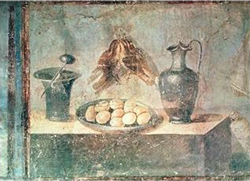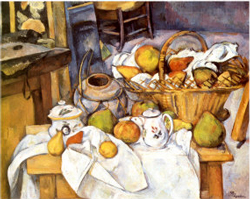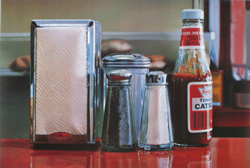
The Long History of Food in Art
The Long History of Food in Art
Still life paintings of edibles such as bread, fruits and vegetables have been around for centuries. Archaeologists have found drawings of food on the walls of Egyptian pyramids. It was believed that, through magical properties, they would nourish those gone on to the after life.

Ancient history has recorded the Greeks and Romans’ pride in the realistic depiction of food in artworks. A glass bowl of fruit was commonly included in Roman paintings to boast of the delicacies that the rich citizens of Rome enjoyed, and of the generous hospitality they had to offer. During the middle ages, still life elements were used for symbolic purposes.
Renaissance Still Life
Throughout the eras, still life paintings have shown exceptional compositional attributes. During the Renaissance period, still life was revived and subtly incorporated in paintings with a religious theme. Realism and meticulous detail were prized. Eventually, the interest in strict religious representations waned, and everyday objects such as vases of flowers became popular around 1475.
In the 16th and 17th centuries, the art world became interested in scientific examination. Natural inanimate objects were studied and depicted by artists in their most realistic form. A distancing from the moral messages of religious paintings brought on an urge to show the shape and texture of an object for its mere beauty. Still life had become a distinctive genre.
The still life and food in art movement spread throughout the world. Because religious paintings had become a controversial subject due to the reformed protestant church, artists turned to still life as their main source of inspiration. In the forefront were the Dutch painters who introduced the simple but impressive kitchen and market-type paintings, which included various displays of food fare on counters and tables. Paintings of feasts and banquets were also popular.
Contemporary Still Life
French artist Paul Cezanne (1839-1906) is renowned for his numerous paintings of fruit. He enthusiastically adopted the still life genre. His still life illustrations are viewed as traditional and modern – traditional because the fruits and vegetables are easy to identify, and modern because they appear as decorative items; they do not trigger the senses. They do not posses a hint of aroma or tactile attributes, or offer a vision of bright colour. Cezanne’s important work entitled ‘Still Life with Fruit Basket’ (1880-90) is not only a good example of stylized representation of food in art, but also a skilful display of a ‘trompe l’oeil’ exercise (illusionism). It is a magnificent tableau consisting of a small wooden table draped with a white cloth on which rests a basket containing several apples and pears. The illusion occurs as the onlooker’s perspective shifts because the fruit basket appears to not only sit on the table, but also on the floor that rises above the table, making this shift in dimension possible. Other notable food creations by Cezanne are ‘Still Life with Plate of Cherries’ (1885-87), and ‘Apples, Peaches, Pears and Grapes’ (1879-80).

Impressionist Vincent Van Gogh (1853-1890) added his unique touch and applied a particular stylistic technique to his still life paintings. He created a series of sunflower paintings because they were one of his favourite subjects, but he also produced many paintings that included food. An early one entitled ‘Basket with Potatoes’ (1885) is a study of the effects achieved by using a palette of limited colors. His intention was to create shadows that would give realistic solidity and weight to the vegetables. Other famous creations of food in artwork by Van Gogh were ‘Still Life with Quinces and Lemons’ (1887) and ‘Still Life with Carafe and Lemons’ (1887).
Modern Day Still Life with Purpose
Almost anything inert can become the subject for a still life painting. For some artists, the challenge is in painting ordinary objects in order to demonstrate their compositional skill or lighting technique, as these items are magically brought to life. It was Picasso’s passion to paint still life. Pop artists like Warhol criticized or emphasized social issues by painting ordinary soup cans. Modern artist Ralph Goings painted ‘A-1 Sauce’ (1995), a collection of condiments on a table with light falling onto them from a high window. Not necessarily a romantic image, but the hues, shapes and composition create a certain mood that captures the viewer’s attention.

Food in art is also used in the practice of Feng Shui. The item, color and lighting are meant to calm the mind, and their placement draws positive energy into your living environment. Chinese Feng Shui deems that a still life consisting of a basket of fruit is an element that will promote health and bring balance to your life.
Food in art is prevalent, and whether it is used to express bountiful harvests, to give thanks, to boast the artist’s talent, or to communicate an opinion, it will always be a presentation that appeals to viewers.
Donovan Gauvreau
Art Historian, Donovan Gauvreau lectures about art therapy with a focus on creativity development. He believes we can learn from the great masters in art to communicate ideas and feelings through painting. He provides content for www.AaronArtPrints.org to educate and inspire people to take a glimpse into an artist's life to better understand the meaning behind their work.












